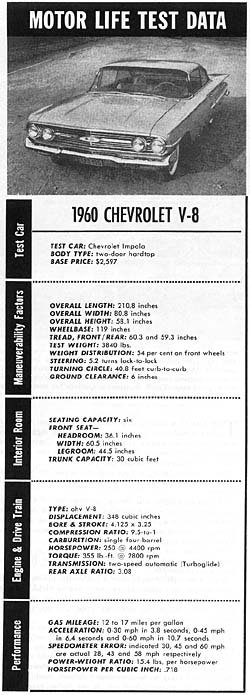| Steering was the usual General Motors power type that engaged only when the driver had applied pressure to turn the wheel. As a result, it had a distinct road feel which is sadly lacking with full-time systems. It was slow, though, requiring five turns lock-to-lock.
The overall driving feel was solid but not agile. For a car its size, the Chevy was cumbersome at first because there were no points of reference at the corners of the broad, flat hood to aid placement in tight situations. Driving and parking were both awkward until one realized the car was not as big as it seemed. Cornering ability was good, though marred by considerable body lean because of the soft springing. The ride was excellent when the surface was smooth, bouncy when it became irregular. Long dips, especially, produced severe oscillations. Indeed, the suspension system typified the whole car; it was engineered for an initial impression of luxury but proved too soft for long range comfort. The seats were another example of this. They were too soft to provide good support over long distances. After a few hours at the wheel, the driver could actually feel the frame inside the seat back. Rear seat comfort was very poor for a full-sized and moderately expensive car. There was room for two at most. A middle passenger would have difficulties not only with the driveshaft tunnel but also with the U-shaped cut in the seat back. One of the biggest criticisms of interior comfort was the enormous rear window. It was tinted to reduce heat from the sun but it did not eliminate enough of it. |

|